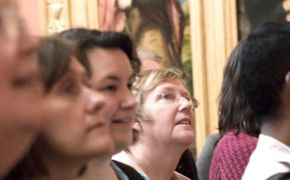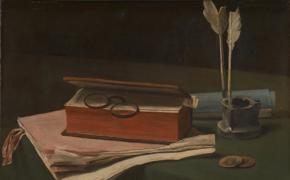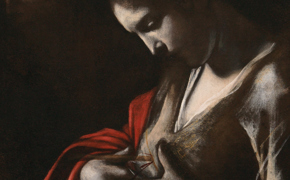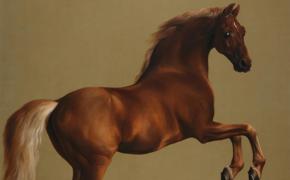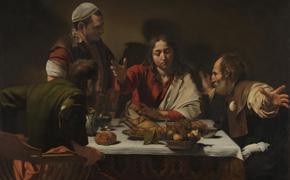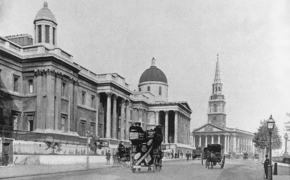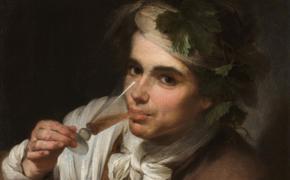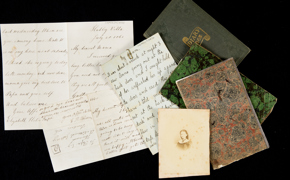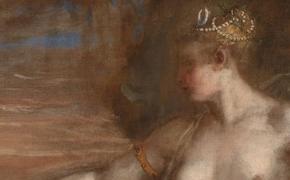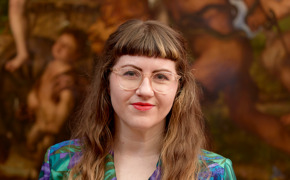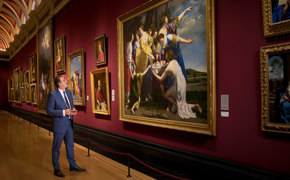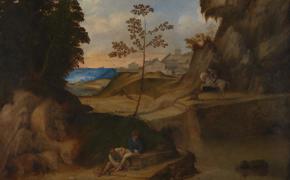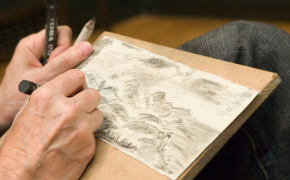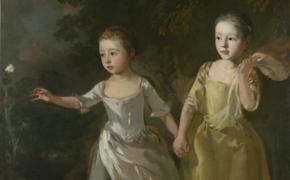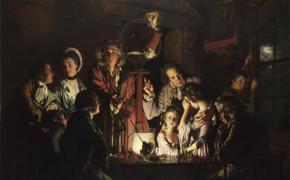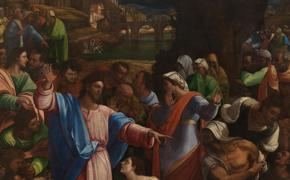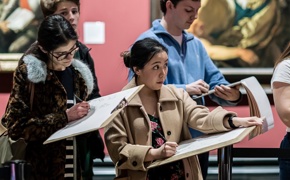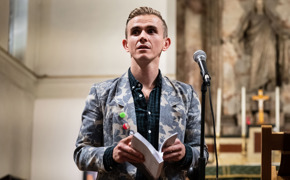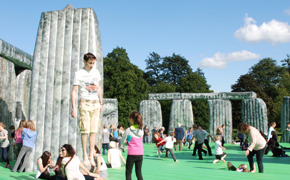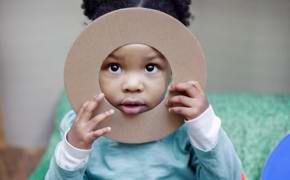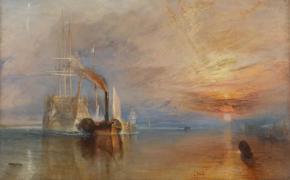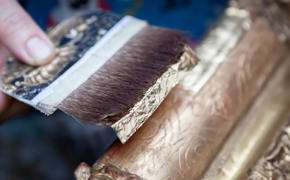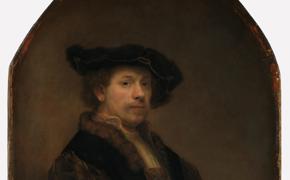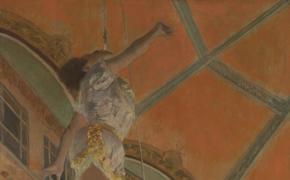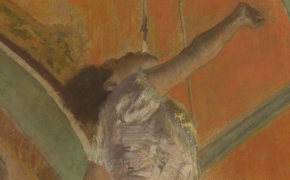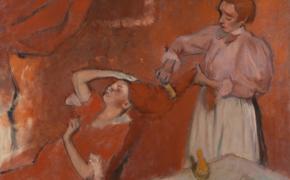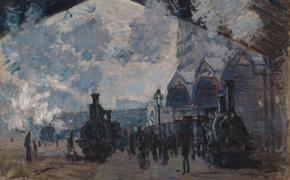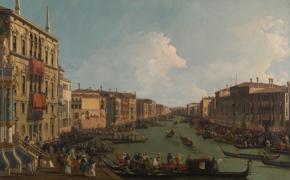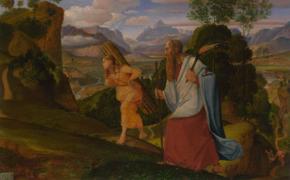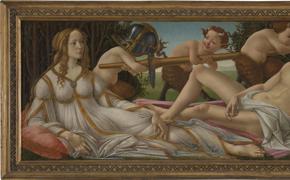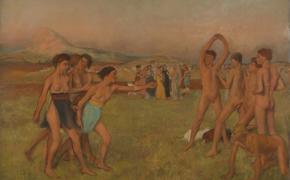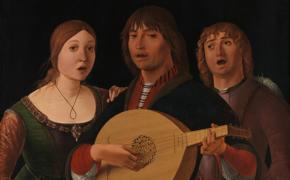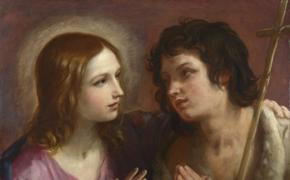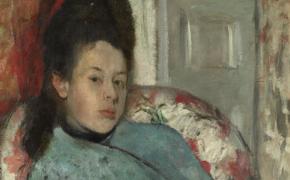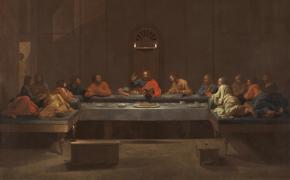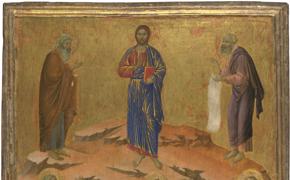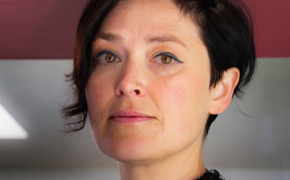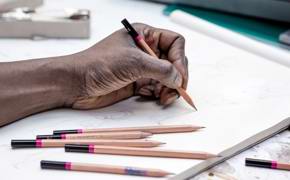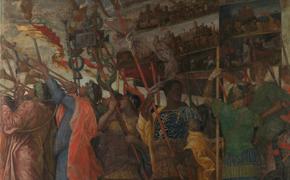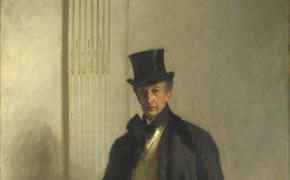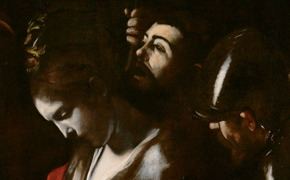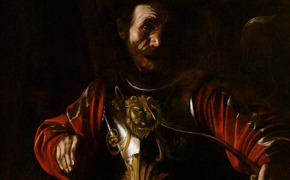
Picture of the month
August 2019: An Experiment on a Bird in the Air Pump
On a moonlit night, 10 people gather around a table; their faces illuminated by candlelight.
A young, anxious girl looks upwards. We follow her gaze and see a glass jar and, inside it, a bird – a rare cockatiel.
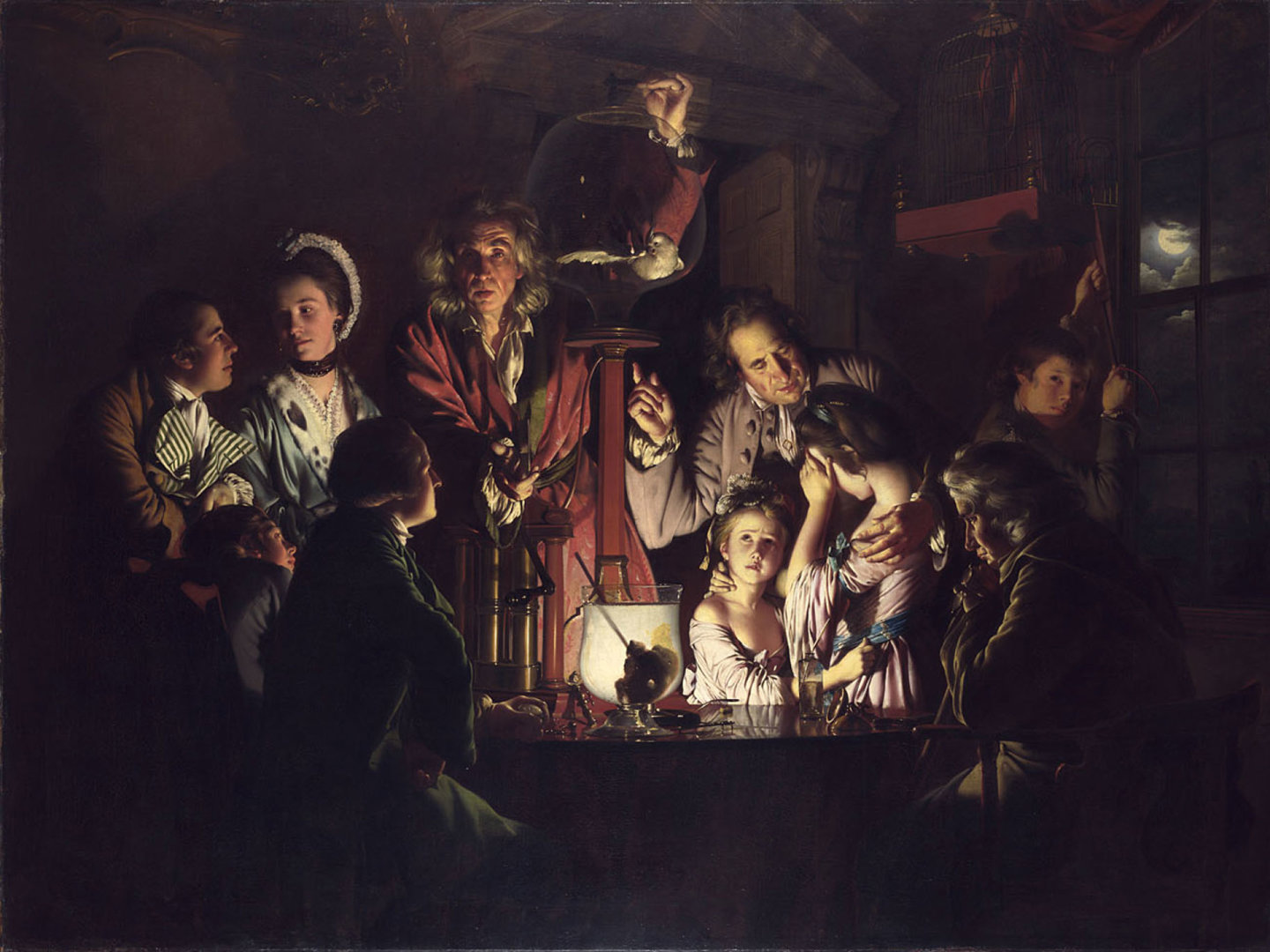
The jar is held by a scientist. He is showing the group how sucking air out of a jar creates a vacuum. Starved of oxygen, the bird grows distressed, and the scientist demonstrates how it cannot breathe within the vacuum.
The group reacts to this experiment in different ways. The two young girls are clearly upset. A fatherly figure either consoles them or explains the experiment to them. In contrast, the young boy directly opposite leans in, engrossed. Next to him, a man holds a stopwatch, timing the experiment. Another man, hands clasped, appears deep in thought. The young couple seem only interested in each other.
The fate of the bird is held in suspense. A boy holds an open cage – is this so that the bird can go back in safely, or has he just released it?
Wright 'of Derby' may have left some clues within the painting. Some believe the glass container on the table holds a skull, which in paintings usually acts as a 'memento mori' – a reminder that we will all die one day. Candles and skulls are often companions in art, the candle demonstrating the passage of time and the skull its end.
An Experiment on a Bird in the Air Pump can be seen as a work of the Enlightenment, an intellectual and scientific movement across Europe in the 18th century. Alongside the Industrial Revolution, this was a time of radical social, political and technological change.
The children so starkly lit in the painting are part of the generation who will inherit this new world, and who, like us, must decide where they stand on the ethical questions raised by science and progress.
Related events
-
Category:Tour, Free
-
Category:Course, From £70.50
Thinking about art: Philosophical approaches to art history
Tuesday, 2 April 2024 - Tuesday, 7 May 20243.30 - 5.30 pm BSTOnline event -
Category:Talk, Free
Ten-minute talk
Curator's introduction: 'The Last Caravaggio'
Various dates, first upcomingWednesday, 1 May 202412 - 12.10 pm -
Category:Course, From £70.50
Stories of art: 1700-1800
Wednesday, 17 April 2024 - Wednesday, 22 May 20245.30 - 7.30 pm BSTOnline event -
Category:Lunchtime talk, Free
Velázquez, portraitist
Friday, 3 May 20241 - 1.30 pm (drop-in) -
Category:Course, From £35.25
Caravaggio: Among the light and shadows
Thursday, 9 May 2024 - Thursday, 23 May 20243.30 - 5 pm BSTOnline event -
Category:Talk, Free
Collecting histories: Tales from the National Gallery
NG200 Members' talk and Q&A
Thursday, 9 May 20246 - 7 pm BSTOnline eventMembers -
Category:Experience, Free
Big Birthday Weekend Late and Light Show
Friday, 10 May 2024 -
Category:Talk, From £18
A tour of celebration
NG200 Members' tour
Friday, 10 May 2024 - FULLY BOOKEDTour times- 10.30 am - 12 pm
- 1 - 2.30 pm
- 3.30 - 5 pm
Members -
Category:Tour, From £20
Archive show-and-tell
NG200 Members' tour
Friday, 10 May 2024 - FULLY BOOKEDTour times- 11 am - 12 pm
- 2.30 - 3.30 pm
- 4 - 5 pm
Members -
Category:Talk, From £18
The Venetian Room: Gallery 29, history and art
NG200 Members' tour
Fully booked.Friday, 10 May 202411 am - 12 pmMembersThe Venetian Room: Gallery 29, history and art: NG200 Members' tour is Fully booked -
Category:Talk, From £20
A contemporary art tour
NG200 Members' tour
Fully booked.Friday, 10 May 20242 - 3 pmMembersA contemporary art tour: NG200 Members' tour is Fully booked -
Category:Creative session, Free
Big Birthday family weekend
Various dates, first upcomingSaturday, 11 May 202411 am - 4 pmFamilies, for all ages -
Category:Talk, From £18
Members' talk: The Last Caravaggio
Members' talk and private view
Wednesday, 15 May 2024 - FULLY BOOKEDTalk times- 8 - 8.40 am
- 9 - 9.40 am
Members -
Category:Talk, From £215
A morning with Dr Gabriele Finaldi’s masterpieces
Members' breakfast talk
Fully booked.Thursday, 16 May 20248 - 10 amMembersA morning with Dr Gabriele Finaldi’s masterpieces: Members' breakfast talk is Fully booked -
Category:Talks & conversations, Free
Pause with a painting
Giorgione's 'Il Tramonto (The Sunset)''
Thursday, 16 May 202411am11 - 11.45 am (drop-in) -
Category:Creative session, Free
Creative workshop
A certain kind of light
Various dates, first upcomingThursday, 16 May 20244 - 5 pm -
Category:Discussion, Free
The Painter's Daughters
Members' book club
Thursday, 16 May 20246 - 7 pm BSTOnline eventMembers -
Category:Talk, Free
Curator's introduction
The Last Caravaggio
Tuesday, 21 May 20241 - 2 pm BSTOnline event -
Category:Talk, Free
Audio Art: Utterly in the picture
Joseph Wright 'of Derby'
Thursday, 23 May 20241 - 2 pm (drop-in) -
Category:Lunchtime talk, Free
Competition and collaboration in the 'Raising of Lazarus'
Friday, 24 May 20241 - 1.30 pm (drop-in) -
Category:Experiences
Friday Lates
Fridays -
Category:Talks & conversations, Free
Friday Lates: The Triumph of Art
Ed Hall in conversation
Friday, 24 May 20246.15 - 7 pm -
Category:Creative session, Free
Friday Lates: The Triumph of Art
Life drawing with banners
Friday, 24 May 2024Session times- 6.15 - 7 pm
- 7.15 - 8 pm
-
Category:Talks & conversations, Free
Friday Lates: The Triumph of Art
Laura Grace Ford: Remembering the National Gallery
Friday, 24 May 20246.30 - 7.15 pm -
Category:Talks & conversations, Free
Friday Lates tour and poetry readings
SJ Fowler and guests
Friday, 24 May 20247 - 7.45 pm -
Category:Talks & conversations, Free
Friday Lates: The Triumph of Art
Jeremy Deller in conversation with Mary Beard
Friday, 24 May 20247.30 - 8.15 pm -
Category:Creative session, Free
May half-term
Sensory connections
Wednesday, 29 May 202411 am - 4 pm (drop-in)Families, for all ages -
Category:Course, From £11.75
In focus: Turner
Wednesday, 29 May 20245.30 - 7.30 pm BSTOnline event -
Category:Creative session, Free
May half-term
Gold reflections
Thursday, 30 May 202411 am - 4 pm (drop-in)Families, for all ages -
Category:Creative session, Free
Talk and draw
Self Portrait at the Age of 34
Friday, 31 May 20244 - 5 pm BSTOnline event -
Category:Talk, From £10
Curator's introduction: Discover Degas and Miss La La
Members' talk and Q&A
Tuesday, 4 June 20244 - 5 pm BSTOnline eventMembers -
Category:Talk, From £18
Members' Preview Tour: Discover Degas and Miss La La
Members' Preview tour
Wednesday, 5 June 2024Tour times- 8.45 - 10.15 am
- 4.30 - 6 pm
Members -
Category:Talk, From £18
Members' preview day: Degas and the collection
Members' preview tour
Wednesday, 5 June 202411.45 am - 12.45 pmMembers -
Category:Course, From £70.50
Stories of art 1800-1900
Wednesday, 5 June 2024 - Wednesday, 10 July 20245.30 - 7.30 pm BSTOnline event -
Category:Talk, From £20
Sourced's postcard tour of Canaletto
Members' guided tour
Wednesday, 12 June 20243 - 4.30 pmMembers -
Category:Talk, Free
The Sacrifice – Abraham, Isaac and Ishmael in art
Members' talk and Q&A
Thursday, 13 June 20244 - 5 pm BSTOnline eventMembers -
Category:Creative session, From £50
Folklore & floriography: Scent workshop with 20A Aromatherapy
Members' creative workshop
Saturday, 15 June 202410.30 am - 1 pmMembers -
Category:Talk, Free
A mindful look at Botticelli's 'Venus and Mars'
Members' talk and Q&A
Thursday, 20 June 20245.30 - 6.30 pm BSTOnline eventMembers -
Category:Tour, Paid
Guided tours of Longford Castle
Various dates, March - September - FULLY BOOKED2 - 4.30 pm -
Category:Talk, From £20
Members' tour: Discover Degas and Miss La La
Members' exhibition tour
Monday, 24 June 20248.45 - 9.45 amMembers -
Category:Talk, From £18
Members' tour: Degas and the collection
Members' tour
Monday, 24 June 2024Tour times- 11 am - 12 pm
- 3.30 - 4.30 pm
Members -
Category:Talk, From £18
A tour of celebration
Members' tour
Tuesday, 25 June 2024Tour times- 10.30 am - 12 pm
- 12.30 - 2 pm
- 2.30 - 4 pm
Members -
Category:Discussion, Free
Querying the lives of saints
Members' talk and Q&A
Thursday, 27 June 20244 - 5 pm BSTOnline eventMembers -
Category:Talk, From £20
Members' tour: Discover Degas and Miss La La
Members' exhibition tour
Monday, 1 July 20248.45 - 9.45 amMembers -
Category:Talk, From £18
Members' tour: Degas and the collection
Members' Tour
Monday, 1 July 2024Tour times- 11 am - 12 pm
- 3.30 - 4.30 pm
Members -
Category:Talk, From £18
Members' talk: The Last Caravaggio
Members' talk and private view
Wednesday, 3 July 2024Talk times- 8 - 8.40 am
- 9 - 9.40 am
Members -
Category:Talk, Free
Poussin, the storyteller
Members' talk and Q&A
Thursday, 4 July 20244 - 5 pm BSTOnline eventMembers -
Category:Creative session, From £50
Calligraphy with Flourish & Plume
Members' creative workshop
Sunday, 7 July 202411 am - 12 pmMembers -
Category:Talk, From £10
Sacred Art, Revisited
Members' livestream tour and Q&A
Monday, 8 July 20246.30 - 7.30 pm BSTOnline eventMembers -
Category:Discussion, From £30
In conversation with Hettie Judah and Amelia Abraham
Member mornings
Tuesday, 9 July 20248.30 - 9.45 amMembers -
Category:Talk, From £18
Members' talk: The Last Caravaggio
Members' talk and private view
Wednesday, 10 July 2024Talk times- 8 - 8.40 am
- 9 - 9.40 am
Members -
Category:Creative session, From £10
Give it a go: Drawing landscapes
Members' workshop
Thursday, 11 July 20245.30 - 7 pm BSTOnline eventMembers -
Category:Talk, From £18
A tour of celebration
Members' tour
Tuesday, 16 July 2024Tour times- 10.30 am - 12 pm
- 12.30 - 2 pm
- 2.30 - 4 pm
Members -
Category:Course, From £11.75
In focus: John Singer Sargent
Wednesday, 17 July 20245.30 - 7.30 pm BSTOnline event -
Category:Talk, Free
Reflecting on The Last Caravaggio
Members' talk and Q&A
Thursday, 18 July 20244 - 5 pm BSTOnline eventMembers -
Category:Talk, From £10
Pause and reflect on 'The Last Caravaggio'
Members' reading group
Monday, 22 July 2024Session times- 11.30 am - 12.30 pm
- 1 - 2 pm
Members -
Category:Talk, From £18
A tour of celebration
Members' tour
Tuesday, 30 July 2024Tour times- 10.30 am - 12 pm
- 12.30 - 2 pm
- 2.30 - 4 pm
Members

